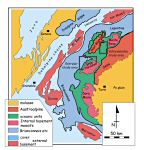Evolution of the metamorphic western Alps
The inner part of the western Alps, straddling the border between France and Italy, contains rocks
that once formed the floor of the Tethys ocean, together with parts of the former continental margin
of "Europe". These rocks are generally now intensely deformed and many show the effects
of metamorphism. Since the 1980s geologists have realized that parts of the continental crustal units
have been buried to depths in excess of 120km, presumably by subduction. Similar metamorphic conditions
are recorded by some of the oceanic units. These eclogites (and their less deeply buried equivalents – blueschists)
now outcrop. While subduction may explain their burial it does not simply explain how these rocks now
come to be at the Earth’s surface. Simple erosion is to a satisfactory mechanism for this because
the sedimentary basins around the Alps should be full of mantle clasts. They are not. So the overburden (mantle)
that lay on top of the deeply buried rocks must remain in the ground. The exhumation of the eclogites
requires tectonic explanations.  Since
the mid 1980s structural geologists have been attempting to identify the structures that exhumed the
eclogites and then to work out their kinematics. Consequently, one of the main areas of debate in Alpine
geology through the 1990s and 21 st century has concerned the structural evolution of the Alpine eclogites
and the rocks around them. And in order to relate the exhumation processes to the formation of the Alps
themselves, geologists have sought to date the structures so that their timing relative to crustal shortening
structures and the rates of exhumation can be estimated.
Since
the mid 1980s structural geologists have been attempting to identify the structures that exhumed the
eclogites and then to work out their kinematics. Consequently, one of the main areas of debate in Alpine
geology through the 1990s and 21 st century has concerned the structural evolution of the Alpine eclogites
and the rocks around them. And in order to relate the exhumation processes to the formation of the Alps
themselves, geologists have sought to date the structures so that their timing relative to crustal shortening
structures and the rates of exhumation can be estimated.
Some of the key study areas can be seen on the map.
Select from the studies below to find out more.
This section outlines the use of Rb-Sr mica geochronology to obtain deformation ages from greenschist
facies shear zones.
A case study in relating the methods to investigate exhumation histories.
A major shear zone in the French-Italian Alps.
Regional overview, timing and models
Regional compilation of data, a discussion on distinguishing extension from contraction in mountain
belts and some models for syn-orogenic exhumation are presented here.
Acknowledgements
Much of the research described here has been a major team effort. Researchers at the time based in
Leeds (Rob Butler, Steve Freeman, Simon Inger, Bob
Cliff, Anna Biggs, Ned Porter ) have collaborated
with a group based in Liverpool (John Wheeler, Steve Reddy) and the Open University (Simon Kelley).
Links to these people are live where indicated.
|| Alpine Tectonics ||
 Since
the mid 1980s structural geologists have been attempting to identify the structures that exhumed the
eclogites and then to work out their kinematics. Consequently, one of the main areas of debate in Alpine
geology through the 1990s and 21 st century has concerned the structural evolution of the Alpine eclogites
and the rocks around them. And in order to relate the exhumation processes to the formation of the Alps
themselves, geologists have sought to date the structures so that their timing relative to crustal shortening
structures and the rates of exhumation can be estimated.
Since
the mid 1980s structural geologists have been attempting to identify the structures that exhumed the
eclogites and then to work out their kinematics. Consequently, one of the main areas of debate in Alpine
geology through the 1990s and 21 st century has concerned the structural evolution of the Alpine eclogites
and the rocks around them. And in order to relate the exhumation processes to the formation of the Alps
themselves, geologists have sought to date the structures so that their timing relative to crustal shortening
structures and the rates of exhumation can be estimated.